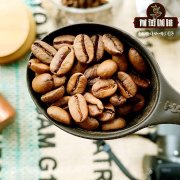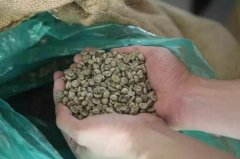The more deadly factor in the preservation of coffee beans is the method of grinding coffee beans into coffee powder.

Professional coffee knowledge exchange more coffee bean information please follow the coffee workshop (Wechat official account cafe_style)
The aroma of a cup of coffee reminds us of the importance of properly preserving raw materials during the food journey. The quality of coffee beans affects the flavor of drinking. Even improperly stored coffee beans may contain toxins. Long-term consumption may have an impact on health.
The origin is the first level of defective bean control.
The coffee on the market comes from coffee beans, and the three major producing countries of coffee are Brazil, Vietnam and Indonesia. These coffee beans are produced in large quantities in equatorial and southern hemispheric countries. During long-distance transportation, coffee beans may produce mold or ochratoxin A because of improper preservation. In addition, coffee beans may cause defective beans due to improper processing in the process of harvesting and baking. With the global warming, the number of defective raw beans screened from producing areas is increasing year by year.
Defective beans refer to the black and brown beans in the raw beans, which are immature and have insect bite marks, and the beans contain twigs and stones. After picking and processing, they will be graded according to the coffee beans of different quality. The allowable defect values are different. When the number of coffee defects is 50 defective beans per kilogram (50 per kilo), it actually means that the coffee should not exceed 50 defective beans per kilogram.
Unopened coffee beans:
Store in a dry, tasteless, cool place to avoid direct sunlight.
When the coffee bag overexpands due to carbon dioxide emissions, the gas can be gently squeezed out of the one-way exhaust valve hole.
Coffee beans that have been opened and are expected to run out within a month:
If the original package has an one-way vent, you can also store it directly in the original coffee package, but remember to seal the bag from the air and discharge the gas from the one-way valve from time to time.
Or the coffee beans can be stored in an opaque container with airtight air isolation and an one-way exhaust valve. The design of the one-way valve is to use the carbon dioxide emitted from the coffee beans to gently squeeze the lighter oxygen out of the exhaust hole to avoid excessive contact oxidation between the coffee beans and the residual oxygen in the bag to accelerate the loss of flavor.
In both of the above methods, the container for storing coffee beans needs to be stored in a dry, tasteless, cool place and avoid direct sunlight.
Coffee beans that are expected to run out in more than a month:
Divide the fresh coffee beans you just bought into small freezer bags (each bag is used for no more than 1 week).
Squeeze out and seal the excess air (or put it together in a fresh box) and keep the ice in the freezer (try not to store it for more than three months).
When you need to use it, take it out an hour earlier and defrost it. The packaging waits until the coffee beans are warmed back to room temperature and then opened to prevent moisture from running in to affect the flavor of the coffee beans.
Coffee beans taken out of the freezer are not recommended to be frozen back! Not only is the moisture easily attached to the coffee beans, but the coffee beans that come into contact with the air after thawing also begin to oxidize and mature and should be consumed as soon as possible.
The preservation of coffee beans sounds a little complicated, but not at all! As long as you remember to cut off the 'oxygen', 'sunshine' and 'moisture', don't buy too many coffee beans at once and use them in the best taste period (within 4 weeks) to get the best flavor of the coffee beans!
Important Notice :
前街咖啡 FrontStreet Coffee has moved to new addredd:
FrontStreet Coffee Address: 315,Donghua East Road,GuangZhou
Tel:020 38364473
- Prev

The preservation of coffee beans is very important, the flavor is very different, the freshness judgment and preservation methods of coffee beans are very important.
Professional coffee knowledge exchange more coffee bean information Please follow the coffee workshop (Wechat official account cafe_style). People often ask why the beans smell so strong, but not after brewing? In fact, the sense of smell of the natural aroma can be clearly identified, and the bean phase can tell whether the beans are aging or not. if the aroma of cooked beans is too strong, you can first expose the coffee beans in the air for five minutes.
- Next

Coffee raw beans | what's the difference between new beans, old beans and old beans in coffee?
Professional coffee knowledge exchange more coffee bean information please follow the coffee workshop (Wechat official account cafe_style) We all know that when buying coffee beans, we should choose freshly roasted ones, after all, coffee beans will enter the flavor period a few days after roasting! Not only coffee cooked beans, in fact, coffee raw beans are also somewhat fresh and stale, but we call them new beans and old beans.
Related
- Guji coffee producing area of Guji, Ethiopia: Humbela, Shakiso, Wulaga
- What is the most expensive variety of Qiloso in BOP multi-variety group?
- How to store the coffee beans bought home?
- Why are Yemeni coffee beans so rare now?
- Ethiopian Sidamo all Red Fruit Sun Sun Santa Vini Coffee beans
- SOE is mostly sour? What does it mean? Is it a single bean? what's the difference between it and Italian blending?
- Is Italian coffee beans suitable for making hand-brewed coffee?
- How to choose coffee beans when making cold coffee? What kind of coffee beans are suitable for making cold coffee?
- Just entered the pit to make coffee, what kind of coffee beans should be chosen?
- Can only Japan buy real Blue Mountain Coffee? What are authentic Jamaican Blue Mountain coffee beans?

